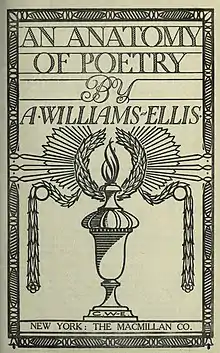Amabel Williams-Ellis
Amabel Williams-Ellis (née Mary Annabel Nassau Strachey; 10 May 1894 – 27 August 1984)[1] was an English writer, critic,[2] and early member of the Bloomsbury Group.[3] As well as her own writings, Williams-Ellis was a prolific editor, translator, and anthologist,[4] compiling collections of fairy stories, folk tales, and science fiction.[5]

Life
Annabel Nassau Strachey was born at Newlands Corner, near Guildford, Surrey,[5] to journalist and newspaper proprietor John Strachey[2] and Amy (née Simpson).[6] Her cousin was Lytton Strachey, and her childhood described as 'glittering and comfortable'.[7]
During World War I, Amabel served as a Voluntary Aid Detachment nurse, which partly inspired an increasing interest in science and anatomy.[7] This led in turn to her scientific writings for children, particularly on notable discoveries and responses to the typical inquiries of children.[7]
On 31 July 1915, Amabel married Clough Williams-Ellis, an architect, with whom she collaborated on a history of the Tank Corps.[8] The couple also worked together on The Pleasures of Architecture (1924), and other works. They had three children: a son and two daughters.[8] Their daughter, Susan Caroline Williams-Ellis (1918–2007) was a successful ceramics designer and manufacturer.[9] Their son was killed during World War II.[7]
Between 1922-23, she was literary editor of The Spectator.[7] Attracted to socialism, Amabel Williams-Ellis described herself as a 'class traitor'.[7]
Works
Over the course of her life, Amabel Williams-Ellis wrote more than 40 books.[10] These included novels, books for children, and histories.[5] She wrote regularly for periodicals, and edited multiple volumes of folk legends, fairy tales, and science fiction.[5] She was significantly inspired by the writer and explorer Mary Kingsley, who she had met in childhood, and who she described as 'an anthropologist before anthropology'.[7] The Times described Amabel Williams-Ellis as someone who 'wrote books to find things out, and seemed prepared to take on anything.'[7]
Death
Amabel Williams-Ellis died on 27 August 1984, at the age of 90.[10] Shortly before her death, she published a memoir: All Stracheys Are Cousins. This showed, wrote The Times, that she was:
an undiminished optimist who had lived a busy and a happy life, and enjoyed her second living of it on the page.[7]
Publications
- The Tank Corps (1919) with Clough Williams-Ellis
- An anatomy of poetry (1922)
- The pleasures of architecture (1924) with Clough Williams-Ellis
- Men who found out: stories of great scientific discoverers (1929)
- The exquisite tragedy; an intimate life of John Ruskin (1929)
- The voyage of the Beagle; adapted from the narratives and letters of Charles Darwin and Capt. Fitz Roy (1931)
- The art of being a woman (1951)
- Fairy tales from the British Isles (1960)
- Darwin's moon: a biography of Alfred Russel Wallace (1966)
- Old World & New World fairy tales (1966)
References
- "Summary Bibliography: Amabel Williams-Ellis". www.isfdb.org. Retrieved 2020-11-23.
- "Amabel Williams-Ellis – National Portrait Gallery". www.npg.org.uk. Retrieved 2020-11-23.
- "Authors : Williams-Ellis, Amabel : SFE : Science Fiction Encyclopedia". www.sf-encyclopedia.com. Retrieved 2020-11-23.
- "Amabel Williams-Ellis | Beware of Magpies". Retrieved 2020-11-23.
- "Amabel Williams-Ellis © Orlando Project". orlando.cambridge.org. Retrieved 2020-11-23.
- "Strachey, John St Loe (1860–1927), journalist and journal proprietor". Oxford Dictionary of National Biography. doi:10.1093/ref:odnb/36340. Retrieved 2020-11-23.
- "Amabel Williams-Ellis". The Times. 29 August 1984.
- "Ellis, Sir (Bertram) Clough Williams- (1883–1978), architect". Oxford Dictionary of National Biography. doi:10.1093/ref:odnb/31839. Retrieved 2020-11-23.
- "Ellis, Susan Caroline Williams- (1918–2007), ceramics designer and manufacturer". Oxford Dictionary of National Biography. doi:10.1093/ref:odnb/99216. Retrieved 2020-11-23.
- "Death of Lady Williams-Ellis". The Times. 28 August 1984.